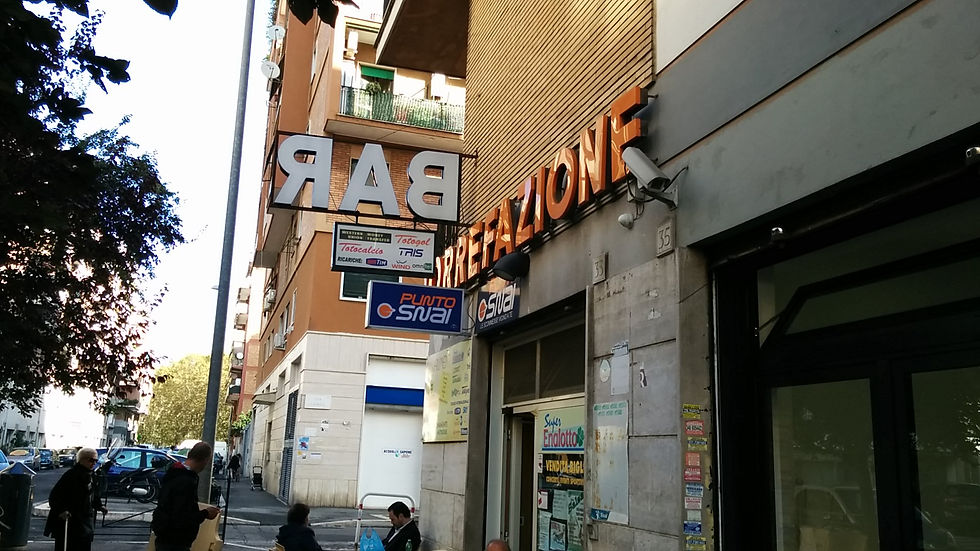FRUMENTI BAR E TORREFAZIONE, VIA ERNESTO NATHAN 33, 00146 ROMA
- coffeeinrome

- Oct 19, 2015
- 4 min read
Rating: Standard, low-end Roman coffee
In many ways, the Frumenti Bar and Torrefazione represents the story of coffee in Rome. It opened in 1966 and had a full operation, it was family run, it was in a new neighborhood of Rome, and it toasted it’s own coffee beans. The outside of the coffee shop still show the prominent ‘Torrefazione’ neon lights. These look rather new, and probably date to the mid-to late 80s. But why does this represent the story of Roman coffee? Because here in Rome you have traditions that are handed down each generation and in the hand-off some things are lost. Many times it’s the quality that is lost – the drive to have happy clientele. But here, it appears that it’s a loss of marketing opportunity. Apparently, the ‘roaster’ here is not functional anymore. Let’s try their coffee, and then see what’s the story.

I walked in gleaming to taste a new coffee roasted locally here in Rome. Asking for a coffee got me this:

Presentation: Ugh, yes. I LIKE Gran Caffè Santos, I actually do, but to see it here made my heart drop. Man, yet again, the story repeats itself… This definitely is not a in-house roasted coffee! We’ll let’s move on: No water offered. Cup was clean, tight, all in order. The espresso was poured just for me, not milked for two cups. The water would have surely been given to me without a problem. I’ll explain why in a sec.
Temperature of Cup: It was warm, good, not scalding, and promised a carefully looked after drink.
Quantity: Rather abundant espresso. Large, cup, long shot. Not complaining yet.
Temperature: It was warm, on the higher temp. side. Still on the mark. I was able to taste it without wanting to spit it out immediately.
Volume/Consistency: Thin, transparant, not oily, not sandy, not silky nor dense. I was left with wanting more out of this typically hearty and oily coffee roaster.
Crema: Look for yourself, but, it was darker than the photo shows. It was rather even, thin, no oiliness. Persistent however, and yet picture perfect for those that think the crema should look like vinyl.

Odor: Here was the off-putting thing, the coffee did indeed smell, but it smelled very acidic. Not in a freshly light-roasted coffee, but in a deeply bitter pungent dark roast. It was odd because the Santos roaster is a decent operation. So it must have been something else.
Taste: It was almost rancid. It was very very bitter, bordering on the side of not wanting to go through with it. But to be totally fair, it wasn’t. The combination of the razor-thin consistency with the very bitter taste made it seem like a rancid drink. Had I put sugar in it, I’m sure it would have opened up to a different type of experience.

Overall: Having had some of the best coffee in Rome with Gran Caffè Santos beans, I’d say that this definitely paled in comparison. However, it wasn’t awful, just very strong and thin Roman coffee.
The setup: The interesting thing of this setup, was not so much the beautiful Faema three-group machine, or the very nice Fiorenzato F6 grinder.

It was the barista himself commanding this. It is the first time in more than 150 cafes reviewed here that I heard so many people enter a place and address the barista by name. In the 10 minutes I spent in this cafe, almost everyone who walked up to the bar called ‘Mauro’ by his first name. Everyone! He was a younger guy in his mid 20s and each person came to ask for a coffee by first asking how ‘Mauro was’. He was charismatic, had something interesting to say to each of the people, and was very attentive to how each of us was drinking our coffee. Class, and charm that totally stood out…

Now to more serious matters: If you see towards the left of the above picture where the setup is shown (the Faema machine), you’ll see that there are some empty espresso bean bins. Upon looking at them I saw that these had the Paraná Caffè brand on them. They were completely empty. There were to types, decaf and normal. Then, I asked the barista if they toasted any of their beans, and he said that they aren’t doing this now. They used to, but not currently… So the sad thing for me, and the story that repeats itself here and throughout Rome, is the loss of a tradition, and a loss of a big opportunity. They have all the necessary expensive equipment and importation networks to do small scale, gourmet coffee roasting, and yet the opportunity is let go. This is why I’m still categorizing this place as a ‘Roaster’. They indeed are, but aren’t taking advantage of all their capital. Maybe a reader here will give them a visit and see if they can convince them to do otherwise?


Bar Frumenti dal 1966
Snai – Sisal – Gastronomia
Frumenti Emilio
Via Ernesto Nathan 33
00146 Roma









Comments